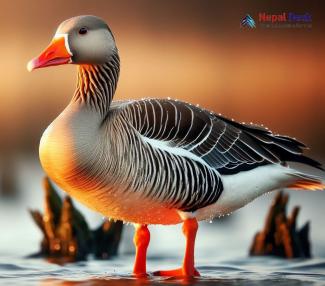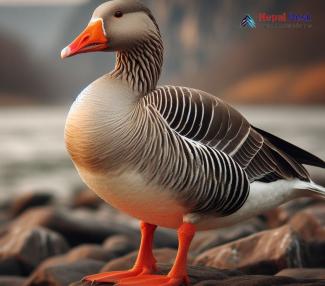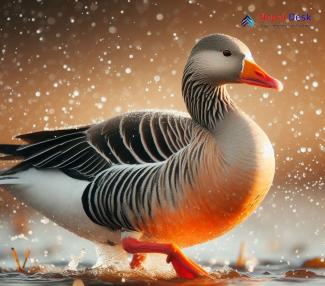The Greater White-fronted Goose (Anser albifrons) is an intriguing bird species found across various parts of the globe. Renowned for their distinctive appearance and fascinating behavior, these geese are a delight for birdwatchers and wildlife enthusiasts alike. It is a species of goose related to the smaller lesser white-fronted goose (A. erythropus). In Europe it has been known as the white-fronted goose and in North America it is also known as the "Greater Whitefront" along with its more familiar name Greater White-fronted Goose. In this article, we'll explore the key features, habitat, diet of the Greater White-fronted Goose, and its presence in Nepal.
Features of the Greater White-fronted Goose
The Greater White-fronted Goose gets its name from the white patch present on its forehead, which contrasts sharply with its otherwise dark plumage. Adult males typically weigh between 5-6 pounds and have a wingspan of up to 53 inches. Females are slightly smaller but share similar physical characteristics.
Another distinguishing feature is their orange-yellow legs and feet, while their bill is pinkish with a white nail on the tip. During the breeding season, they exhibit more prominent white feathering on their fronts, making them easily identifiable from other waterfowl species.
Habitat Preferences
The Greater White-fronted Geese are known to inhabit diverse habitats ranging from marshes and wetlands to grasslands and agricultural lands. During their migration journey, these geese tend to follow traditional routes along major river systems and flyways.
They breed in the Arctic tundra during summer months before heading south to wintering grounds across North America, Europe, Asia, and Africa. Wintering habitats often include estuaries, lakeshores, flooded fields or managed wetlands where they can access suitable vegetation for foraging.
Dietary Habits
These geese are primarily herbivorous feeders but occasionally consume small aquatic animals and invertebrates as well. Their diet consists mostly of grasses, sedges, aquatic plants as well as grains from agricultural fields during winter. They usually forage by employing a grazing and dabbling technique, helping them access the necessary food sources in their respective habitats.
Presence in Nepal
Nepal is known for its rich biodiversity and provides an essential stopover for various migratory bird species, including the Greater White-fronted Goose. Despite not being a regular winter visitor to Nepal, sightings have occurred in places like Chitwan National Park and the Koshi Tappu Wildlife Reserve. Recording their presence helps researchers and conservationists track migratory patterns and implement effective strategies to protect these fascinating birds.
The Greater White-fronted Goose is just one example of the many incredible bird species found around the world. These birds are not only a testament to nature's creativity but also serve as important indicators of our planet's health. By understanding and appreciating these geese more, we can help promote their conservation and ensure that future generations have the opportunity to witness their captivating presence.




